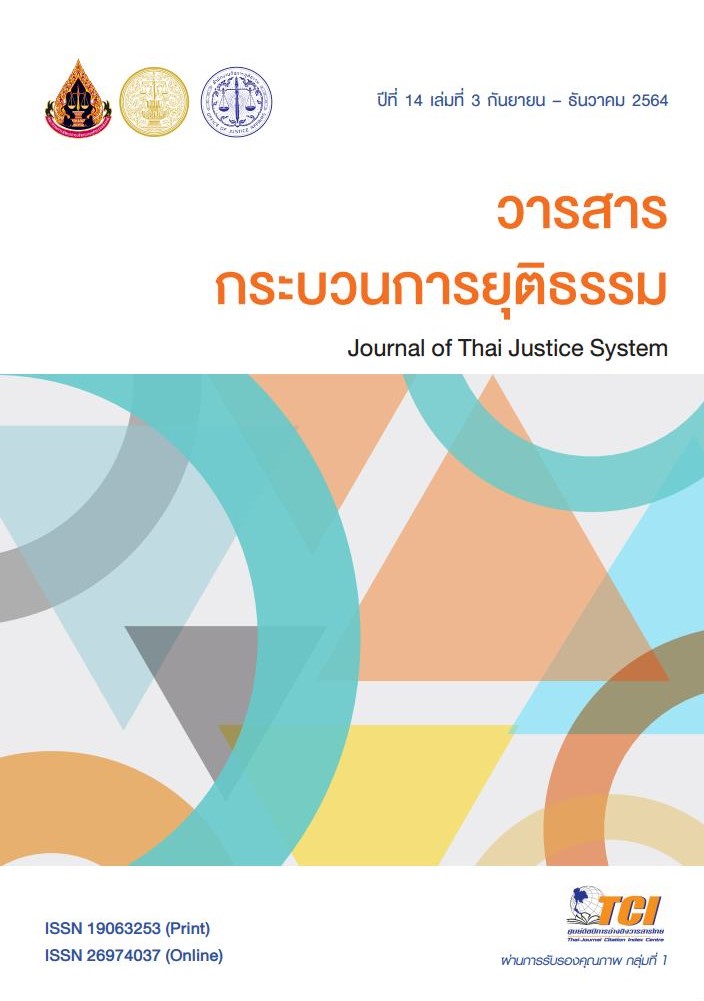การพัฒนาตัวแบบจำลองด้วยบล็อกเชนสำหรับการจัดเก็บข้อมูล ประวัติอาชญากรรม และบูรณาการกระบวนการยุติธรรมในประเทศไทย
Main Article Content
บทคัดย่อ
บล็อกเชนเป็นเทคโนโลยีที่มีศักยภาพในการเชื่อมโยงข้อมูลทำให้เกิดบูรณาการการปฏิบัติงานระหว่างหน่วยงานในกระบวนการยุติธรรมให้มีความโปร่งใส มีกลไกการตรวจสอบเพื่อป้องกันการดัดแปลงข้อมูลอันเป็นหลักฐานสำคัญที่จัดเก็บในระบบและช่วยทำให้การปฏิบัติงานด้านยุติธรรมมีความเป็นธรรมและมีประสิทธิภาพ ทั้งนี้ ด้วยการใช้เทคนิคการเข้ารหัสลับ และการบันทึกข้อมูลแบบกระจายซึ่งไม่อาจเปลี่ยนแปลงได้อันเป็นคุณสมบัติประการสำคัญของบล็อกเชน งานวิจัยนี้เสนอให้เลือกใช้บล็อกเชนสำหรับองค์กรความร่วมมือ โดยเสนอให้หน่วยงานในกระบวนการยุติธรรมพัฒนาโหนดของเครือข่ายบล็อกเชน 3 หน่วยงานแรก คือ สำนักงานตำรวจแห่งชาติ สำนักงานอัยการสูงสุด และสำนักศาลยุติธรรม โดยการเชื่อมโยงระบบสารสนเทศตามพันธกิจหลักภายในที่มีอยู่แล้วของหน่วยงานเหล่านั้นให้เป็นโหนดของบล็อกเชน จากนั้นให้มีหน่วยงานในในกระบวนการยุติธรรม เช่น กรมราชทัณฑ์ และกรมคุมประพฤติ เป็นลำดับต่อไปที่สามารถเชื่อมโยงเป็นโหนดของบล็อกเชนด้วย
งานวิจัยนี้นำเสนอสถาปัตยกรรม และการออกแบบระบบเพื่อสร้างความมั่นคงปลอดภัยแบบวงแหวนหลายขั้น พร้อมข้อเสนอที่เป็นปัจจัยสำคัญสำหรับการพัฒนาบล็อกเชนให้เกิดสัมฤทธิ์ผล ซึ่งประกอบด้วยกลไกการเพิ่มประสิทธิภาพการประมวลผลของบล็อกเชน และการจัดการกับไฟล์ข้อมูลขนาดใหญ่ที่เป็นหลักฐานพยาน และประวัติอาชญากรรมด้วยระบบบริหารจัดการเอกสารควบคู่กับการใช้ค่าแฮช เพื่อพิสูจน์ความถูกต้องครบถ้วนของข้อมูล ตลอดจนการกล่าวถึงความสำคัญของการจัดเตรียมโหนดบล็อกเชนเพื่ออำนวยความสะดวก การประสานงาน และความสำคัญของบุคลากรด้านเทคนิคบล็อกเชน
Article Details
ต้นฉบับที่ได้รับการตีพิมพ์ในวารสาร เป็นลิขสิทธิ์ของวารสารกระบวนการยุติธรรม แต่ความคิดเห็นที่ปรากฏในเนื้อหาของบทความในวารสารกระบวนการยุติธรรม ถือเป็นความรับผิดชอบของผู้เขียนแต่เพียงผู้เดียว
เอกสารอ้างอิง
ชัยพร ทบแป, ประสงค์ ประณีตพลกรัง และนิเวศ จิระวิชิตชัย. (2563). โมเดลสมการโครงสร้างของปัจจัยที่ส่งผลต่อการจัดทํากรอบสถาปัตยกรรมการสับเปลี่ยนเอกสารธุรกรรมอิเล็กทรอนิกส์ด้วยเทคโนโลยีบล็อกเชน. วารสารศรีปทุมปริทัศน์ ฉบับวิทยาศาสตร์และเทคโนโลยี, 12, 79-92.
ประดิษฐ์ แป้นทอง. (2558). ปัญหาและแนวทางในการพัฒนากระบวนการยุติธรรมของประเทศไทย, วารสารกฎหมาย. 8(16), 31-44.
สำนักงานพัฒนาธุรกรรมทางอิเล็กทรอนิกส์. (2560). บทนำเกี่ยวกับเทคโนโลยีความปลอดภัยของข้อมูล. ค้นเมื่อ 15 พฤษภาคม 2563, จาก https://www.nrca.go.th/content/02-1.html
สำนักงานพัฒนารัฐบาลดิจิทัล. (2562). การใช้เทคโนโลยีบล็อกเชนสำหรับภาครัฐ. ค้นเมื่อ 15 พฤษภาคม 2563, จาก https://www.dga.or.th/upload/download/file_ff487bacfb3198a615ca75112b8d156c.pdf
สำนักงานสถิติแห่งชาติ. (2563). แผนแม่บทระบบสถิติของประเทศ,รายงานการติดตาม ระดับพื้นที่ ประจำปีงบประมาณ พ.ศ. 2563 ด้านสังคม สาขายุติธรรม ความมั่นคง การเมืองและการปกครอง.ค้นเมื่อ 15 พฤษภาคม 2563, จาก https://oslist.smp.nso.go.th/report/stat/mission/detail?dmt=1&Year=2563&SubjectId=12
หนังสือต่างประเทศ
Chaisuriya, S., Keretho, S., Sanguanpong, S., & Praneetpolgrang, P. (2018). A Security Architecture Framework for CriticalInfrastructure with Ring-based Nested Network Zones. 2018 10th International Conference on Knowledge and Smart Technology (KST). 248-253.
Chaisuriya, S., Keretho, S., Sanguanpong, S., & Thoppae, C. (2021). Ring-Based cybersecurity architecture for critical infrastructure. Turkish Journal of Computer and Mathematics Mathematics Education, 12(6), 2826-2840.
Comrey, A. L., & Lee, H. B. (2013). A first course in factor analysis (2nd ed.). NY: Psychology Press.
Creswell, J. W., & Plano Clark, V. L. (2018). Designing and conducting mixed methods research (3rd ed.). LA: Sage Publications.
Department of Defense Standard. (1985). Department of defense trusted computer system evaluation criteria. Fort Meade: National Computer Security Center. Retrieved May 25, 2020 from https://csrc.nist.gov/csrc/media/publications/conference-paper/1998/10/08/proceedings-of-the-21st-nissc-1998/documents/early-cs-papers/dod85.pdf
e-Estonia. (2020). e-law. Retrieved May 25, 2020, from https://eestonia.com/solutions/security-and-safety/e-law
Guardtime. (2020). KSI blockchain in Estonia. Retrieved May 25, 2020, from https://e-estonia.com/wp-content/uploads/2020mar-faq-ksi-blockchain-1-1.pdf
ISECT. (2015). Guidelines for the design and implementation of network security. Retrieved May 15, 2020, from https://www.iso.org/standard/51581.html?browse=tc
Supreme People's Court of the People's Republic of China. (2019). Chinese courts and internet judiciary. Retrieved May 25, 2020, from http://english.court.gov.cn/2019-12/18/content_37529518.htm
Thoppae, C., & Jirawichitchai, N. (2020). A Blockchain Secured Electronic Transaction Document Interchange Architecture (DIA) : A Public Sector Analysis from Thailand. International Journal of Innovation, Creativity and Change. 14(12), 1153-1172.
Thoppae, C., & Praneetpolgrang, P. (2021). An analysis of a blockchain-enabled e-government Document Interchange Architecture (DIA) in Thailand. Technology Education Management Informatics, 10(3), 1220-1227.
Thoppae, C., Praneetpolgrang, P., & Jirawichitchai, N. (2021). Development of Efficient and Secured Electronic Transaction Document Interchange Architecture Framework among Public Sector with Blockchain Technology. Information Technology Journal, 17(1), 66-75.


